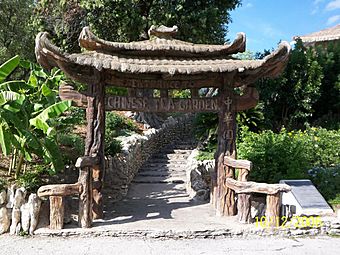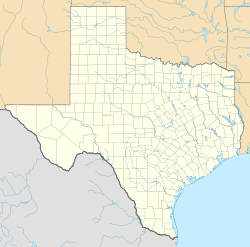San Antonio Japanese Tea Garden facts for kids
Quick facts for kids |
|
|
Chinese Sunken Garden Gate
|
|

Japanese Tea Garden entrance
|
|
| Location | Brackenridge Park, 400 N St. Mary's St San Antonio, Texas, USA |
|---|---|
| Built | 1942 |
| Architect | Rodriguez, Dionicio |
| Architectural style | Faux bois sculpture |
| MPS | Sculpture by Dionicio Rodriguez in Texas MPS |
| NRHP reference No. | 04001167 |
| Added to NRHP | October 22, 2004 |
The San Antonio Japanese Tea Garden, also known as the Sunken Gardens, is a beautiful and historic spot in Brackenridge Park in San Antonio, Texas, USA. It was built in an old limestone rock quarry over 100 years ago. This special garden has also been called the Chinese Tea Gardens and is listed on the U.S. National Register of Historic Places.
Contents
History of the Garden
From Quarry to Garden
The land for the San Antonio Japanese Tea Garden was given to the city in 1899 by George Washington Brackenridge. He was the president of the San Antonio Water Works Company. The quarry itself was first used around 1840 by German masons. They used the limestone from this quarry to build many San Antonio buildings, like the famous Menger Hotel.
Later, around 1880, the Alamo Cement Company started making cement here for 26 years. You can still see the chimney from their old kiln today. A small village grew up around the quarry, where workers and their families lived. Tourists liked to visit them and buy things like pottery and baskets.
Around 1917, Ray Lambert, the City Parks Commissioner, had an idea. He imagined turning the old quarry pit into a beautiful oriental-style garden. His engineer, W.S. Delery, drew up the plans. Work finally began in 1918, thanks to money from private donors. Lambert used prison labor to help shape the quarry. They built walkways, stone arch bridges, an island, and a Japanese pagoda.
The Jingu Family and World War II
At the garden's entrance, a Mexican-born artist named Dionicio Rodriguez (1891-1955) created a special gate. It looks like a Japanese Torii gate, but it's made from concrete that looks just like wood!
In 1919, a Japanese-American artist named Kimi Eizo Jingu was invited to live at the garden. He and his wife, Miyoshi Jingu, took care of the garden and raised their eight children there. In 1926, they opened the Bamboo Room, where visitors could buy light lunches and tea. Kimi Jingu was an expert in the tea business.
Sadly, Kimi Jingu passed away in 1938. Then, in 1941, during World War II, the Jingu family was asked to leave the garden. This happened because of strong anti-Japanese feelings in the country at that time.
To protect the garden from damage, it was renamed the Chinese Tea Garden. Many other Japanese tea gardens in the U.S. were vandalized during the war. A Chinese-American family, Ted and Ester Wu, then ran a snack bar in the pagoda until the early 1960s.
In 1984, Mayor Henry Cisneros helped bring back the garden's original name. In a special ceremony, the Jingu children and representatives from the Japanese government were there to celebrate.
Bringing the Garden Back to Life
Fixing Up the Garden
For many years, the garden was not well cared for. It became damaged and covered in graffiti. The city even thought about closing it because there wasn't enough money for repairs. But the community and park supporters worked hard to keep it open.
In 2005, the city used about $550,000 to fix the roofs of the pagoda-like Pavilion and the Jingu House.
In 2007, former Councilwoman Bonnie Conner and former Mayor Lila Cockrell started a big project. They raised $1.6 million to restore the ponds and waterfall.
On March 8, 2008, the garden had its public re-opening! Members of the Jingu family came back to San Antonio for the event. Mabel Yoshiko Jingu Enkoji, who was born at the garden, was the oldest Jingu family member there.
The Jingu House Reopens
In 2009, more work began to restore the historic Jingu House. This project cost $1 million and was finished in October 2011. Today, the building is a restaurant run by Fresh Horizons Creative Catering. They serve light lunches, just like the Jingu family did in the 1930s.
The Tea Garden is recognized for its history as a rock quarry and its later transformation into a beautiful garden. It is a Texas Civil Engineering Landmark, a Registered Texas Historic Landmark, and is listed on the National Register of Historic Places.
Where to Find the Garden
The San Antonio Japanese Tea Garden is located on the northwestern edge of Brackenridge Park, close to the San Antonio Zoo.
- 3853 N. St. Mary's Street
- San Antonio, Texas 78212
Images for kids



















